Part I: Why plants are important
The objectives for Part I are:
1. To show how certain plants are very important to us.
2. To show that healthy plants are important to keep people healthy.
The instructor can ask children why plants are important to people. Six areas can be discussed:
1. Food: Children can be asked what they had for breakfast. Example: If a child says “Pop Tarts,” explain that flour comes from grains and jam comes from fruits. Example: If a child says “ham and eggs,” explain that these animals were fed corn, oats, etc.
2. Air: Ask the children where the oxygen that we breathe comes from. When leaves make their food with sunlight, they release oxygen.
3. Building Materials: Ask the children what pencils, desks, and houses are made of. Wood comes from trees (plants).
4. Clothing: Ask a child wearing a cotton shirt if s/he knows what it is made of. Ask a child what linen sheets are made from (flax). Many dyes originally came from plants.
5. Gifts, Beauty, Recreation: Ask the children if they give flowers or plants on Mother’s Day, or enjoy planting flower gardens, or playing in parks or sports fields.
6. Medicines: Many medicines come from plants. Example: Aspirin was first found in the bark of willow trees.
Part II: Plant Parts - their function and diseases
The objectives for Part II are:
1. To teach the major parts of a plant (root, stems, leaves, flowers, fruit and seeds) and their basic functions.
2. To teach that each part of a plant can become diseased.
3. To show that plant pathologists are needed to keep plants healthy.
The instructor should discuss the six major parts of a plant. Roots, stems, leaves, flowers, fruits, and seeds.
Each plant part has major functions:
1. Roots absorb minerals and water, and anchor the plants. Show examples of edible roots: carrots, radishes, turnips, or sweet potatoes. Show photographs of how roots can become diseased and not grow well (Figure 3).
|
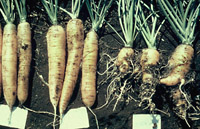
|
|
Figure 3. Root-knot nematode damage on carrots.
(Pathogen = nematodes; nematodes are
microscopic parasitic worms that can attack plants.) Click image for an enlarged printout view. |
2. Stems carry nutrients and water up and down the plant, and support the leaves. Show examples of edible stems: asparagus, celery, or rhubarb. Stems may become diseased (Figure 4).
|
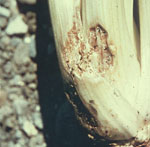
|
|
Figure 4. Sclerotinia pink rot of celery. (Pathogen = fungus; fungi are usually microscopic multicellular organisms that can be beneficial or harmful to plants.) Click image for an enlarged printout view. |
3. Leaves make food (energy from the sun + CO2 + H2O = sugar). Show examples of edible leaves: lettuce, spinach, onion, garlic, or cabbage. Leaves may become diseased (Figure 5).
|
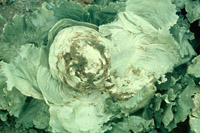
|
|
Figure 5. Bacterial soft rot of lettuce. (Pathogen = bacterium; bacteria are single-celled microscopic organisms.) Click image for an enlarged printout view. |
4. Flowers provide nectar, attract insects, and produce fruits and seeds. Show examples of edible flowers: rose hips, broccoli florets and artichokes. Flowers may become diseased (Figure 6).
|

|
|
Figure 6. Downy mildew of broccoli. (Pathogen = fungus; fungi are microscopic multicellular organisms that can be beneficial or harmful to plants.) Click image for an enlarged printout view. |
5. Fruits have the seeds inside. Show examples of edible fruits: apples, oranges, green peppers, or cucumbers. Explain that although cucumbers, tomatoes, green peppers and pumpkins are grown and sold as vegetables, they are actually fruits because they are produced from flowers and contain seeds. Fruits may become diseased (Figure 7).
|
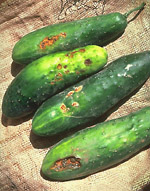
|
|
Figure 7. Cucumber belly rot. (Pathogen = fungus; fungi are microscopic multicellular organisms that can be beneficial or harmful to plants.) Click image for an enlarged printout view. |
6. Seeds are produced by plants in order to make new plants for the next generation. Show examples of edible seeds. Sunflower seeds, popcorn (avoid nuts). Seeds may become diseased (Figure 8).
|
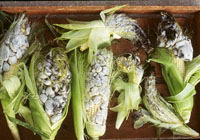
|
|
Figure 8. Common smut of corn. (Pathogen = fungus; fungi are microscopic multicellular organisms that can be beneficial or harmful to plants.) Click image for an enlarged printout view. |
Lab exercise
The lesson objectives for the lab exercise are:
1. To become familiar with the various parts of plants by eating samples of each.
2. To appreciate the value of different plant parts as food.
3. To appreciate how the world would be different if plant pathologists did not keep plants healthy.
Ask children to line up and receive a piece of carrot (root), celery (stem), lettuce (leaf), broccoli (flower and stem), cucumber (fruit), and popcorn (seed). Provide Ranch dressing and have the children return to their seats and eat each plant part. While they are eating, the instructor can ask what plant part they are eating. Ask the children how their lives would be different if there were no plant pathologists to keep their food healthy.
Discussion Questions
1. Why are plants important to people?
2. Name a root, stem, leaf, flower, fruit, and seed that you like to eat.
3. Do plants get diseased? Why?
4. Why is a tomato a fruit?
5. What are plant pathologists and what do they do?
6. What would happen if we could not prevent plant diseases?
Answers to Discussion Questions
1. Why are plants important to people?
They provide air, food, medicines, clothing, flowers, recreation, and building materials.
2. Name a root, stem, leaf, flower, fruit, and seed that you like to eat.
Carrot, celery, lettuce, broccoli, cucumber, and popcorn, respectively or other suggestions.
3. Do plants get diseased? Why?
Yes, they get diseases, just as people do, because organisms called pathogens infect them.
4. Why is a tomato a fruit?
Fruits have seeds inside even though they are sold as vegetables.
5. What are plant pathologists and what do they do?
Plant pathologists are scientists who study plant diseases. They help growers prevent and treat diseases on their plants.
6. What would happen if we could not prevent plant diseases?
The amount and quality of food, building materials, clothing, ornamentals, and medicines would be reduced.
